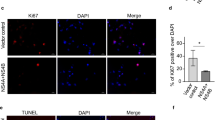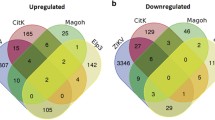Abstract
Zika virus (ZIKV) infection could disrupt neurogenesis and cause microcephaly in neonates by targeting neural progenitor cells (NPCs). The tumor suppressor p53-mediated cell cycle arrest and apoptotic cell death have been suggested to be activated upon ZIKV infection, yet the detailed mechanism is not well understood. In the present study, we investigated the effects of ZIKV-encoded proteins in the activation of p53 signaling pathway and found that, among the ten viral proteins, the nonstructural protein 5 (NS5) of ZIKV most significantly activated the transcription of p53 target genes. Using the immunoprecipitation-coupled mass spectrometry approach, we identified that ZIKV-NS5 interacted with p53 protein. The NS5-p53 interaction was further confirmed by co-immunoprecipitation and GST pull-down assays. In addition, the MTase domain of NS5 and the C-terminal domain of p53 were mapped to be responsible for the interaction between these two proteins. We further showed that ZIKV-NS5 was colocalized with p53 and increased its protein level in the nuclei and able to prolong the half-life of p53. Furthermore, lentivirus-mediated expression of ZIKV-NS5 in hNPCs led to an apparent cell death phenotype. ZIKV-NS5 promoted the cleavage of PARP1 and significantly increased the cell apoptosis of hNPCs. Taken together, these findings revealed that ZIKV-NS5 is a previously undiscovered regulator of p53-mediated apoptosis in hNPCs, which may contribute to the ZIKV-caused abnormal neurodevelopment.





Similar content being viewed by others
References
Abrams RPM, Solis J, Nath A (2017) Therapeutic approaches for zika virus infection of the nervous system. Neurotherapeutics 14:1027–1048
Alzhanova D, Corcoran K, Bailey AG, Long K, Taft-Benz S, Graham RL, Broussard GS, Heise M, Neumann G, Halfmann P, Kawaoka Y, Baric RS, Damania B, Dittmer DP (2021) Novel modulators of p53-signaling encoded by unknown genes of emerging viruses. PLoS Pathog 17:e1009033
Beckerman R, Prives C (2010) Transcriptional regulation by p53. Cold Spring Harbor Perspect Biol 2:a000935
Bianchi FT, Tocco C, Pallavicini G, Liu Y, Verni F, Merigliano C, Bonaccorsi S, El-Assawy N, Priano L, Gai M, Berto GE, Chiotto AM, Sgro F, Caramello A, Tasca L, Ala U, Neri F, Oliviero S, Mauro A, Geley S, Gatti M, Di Cunto F (2017) Citron kinase deficiency leads to chromosomal instability and TP53-Sensitive microcephaly. Cell Rep 18:1674–1686
Bieging KT, Mello SS, Attardi LD (2014) Unravelling mechanisms of p53-mediated tumour suppression. Nat Rev Cancer 14:359–370
Brasil P, Pereira JP Jr, Moreira ME, Ribeiro Nogueira RM, Damasceno L, Wakimoto M, Rabello RS, Valderramos SG, Halai UA, Salles TS, Zin AA, Horovitz D, Daltro P, Boechat M, Raja Gabaglia C, Carvalho de Sequeira P, Pilotto JH, Medialdea-Carrera R, Cotrim da Cunha D, Abreu de Carvalho LM, Pone M, Machado Siqueira A, Calvet GA, Rodrigues Baiao AE, Neves ES, Nassar de Carvalho PR, Hasue RH, Marschik PB, Einspieler C, Janzen C, Cherry JD, Bispo de Filippis AM, Nielsen-Saines K (2016) Zika virus infection in pregnant women in rio de janeiro. N Engl J Med 375:2321–2334
Brault JB, Khou C, Basset J, Coquand L, Fraisier V, Frenkiel MP, Goud B, Manuguerra JC, Pardigon N, Baffet AD (2016) Comparative analysis between flaviviruses reveals specific neural stem cell tropism for zika virus in the mouse develo** neocortex. EBioMedicine 10:71–76
Breuss M, Fritz T, Gstrein T, Chan K, Ushakova L, Yu N, Vonberg FW, Werner B, Elling U, Keays DA (2016) Mutations in the murine homologue of TUBB5 cause microcephaly by perturbing cell cycle progression and inducing p53-associated apoptosis. Development 143:1126–1133
Campos GS, Bandeira AC, Sardi SI (2015) Zika virus outbreak, Bahia, Brazil. Emerg Infect Dis 21:1885–1886
de Sousa JR, Azevedo RSS, Martins AJ, Araujo MTF, Moutinho ERC, Vasconcelos BCB, Cruz ACR, Oliveira CS, Martins LC, Vasconcelos BHB, Casseb LMN, Chiang JO, Quaresma JAS, Vasconcelos PFC (2018) Correlation between apoptosis and in situ immune response in fatal cases of microcephaly caused by zika virus. Am J Pathol 188:2644–2652
Dick GW, Kitchen SF, Haddow AJ (1952) Zika virus. I. Isolations and serological specificity. Trans R Soc Trop Med Hyg 46:509–520
Donato R, Miljan EA, Hines SJ, Aouabdi S, Pollock K, Patel S, Edwards FA, Sinden JD (2007) Differential development of neuronal physiological responsiveness in two human neural stem cell lines. BMC Neurosci 8:36
Duffy MR, Chen TH, Hancock WT, Powers AM, Kool JL, Lanciotti RS, Pretrick M, Marfel M, Holzbauer S, Dubray C, Guillaumot L, Griggs A, Bel M, Lambert AJ, Laven J, Kosoy O, Panella A, Biggerstaff BJ, Fischer M, Hayes EB (2009) Zika virus outbreak on Yap Island, Federated States of Micronesia. N Engl J Med 360:2536-2543
Ghouzzi VE, Bianchi FT, Molineris I, Mounce BC, Berto GE, Rak M, Lebon S, Aubry L, Tocco C, Gai M, Chiotto AM, Sgro F, Pallavicini G, Simon-Loriere E, Passemard S, Vignuzzi M, Gressens P, Di Cunto F (2016) ZIKA virus elicits P53 activation and genotoxic stress in human neural progenitors similar to mutations involved in severe forms of genetic microcephaly. Cell Death Dis 7:e2440
Hou WH, Cruz-Cosme R, Armstrong N, Obwolo LA, Wen FY, Hu WH, Luo MH, Tang QY (2017) Molecular cloning and characterization of the genes encoding the proteins of Zika virus. Gene 628:117–128
Jenkins LMM, Durell SR, Mazur SJ, Appella E (2012) p53 N-terminal phosphorylation: a defining layer of complex regulation. Carcinogenesis 33:1441–1449
Kubbutat MH, Jones SN, Vousden KH (1997) Regulation of p53 stability by Mdm2. Nature 387:299–303
Laurent-Rolle M, Morrison J, Rajsbaum R, Macleod JML, Pisanelli G, Pham A, Ayllon J, Miorin L, Martinez-Romero C, tenOever BR, Garcia-Sastre A (2014) The Interferon signaling antagonist function of yellow fever virus NS5 protein is activated by type i interferon. Cell Host Microbe 16:314–327
Li C, Xu D, Ye Q, Hong S, Jiang Y, Liu X, Zhang N, Shi L, Qin CF, Xu Z (2016) Zika virus disrupts neural progenitor development and leads to microcephaly in mice. Cell Stem Cell 19:120–126
Little JN, Dwyer ND (2019) p53 deletion rescues lethal microcephaly in a mouse model with neural stem cell abscission defects. Hum Mol Genet 28:434–447
Marjanovic M, Sanchez-Huertas C, Terre B, Gomez R, Scheel JF, Pacheco S, Knobel PA, Martinez-Marchal A, Aivio S, Palenzuela L, Wolfrum U, McKinnon PJ, Suja JA, Roig I, Costanzo V, Luders J, Stracker TH (2015) CEP63 deficiency promotes p53-dependent microcephaly and reveals a role for the centrosome in meiotic recombination. Nat Commun 6:7676
Muffat J, Li Y, Omer A, Durbin A, Bosch I, Bakiasi G, Richards E, Meyer A, Gehrke L, Jaenisch R (2018) Human induced pluripotent stem cell-derived glial cells and neural progenitors display divergent responses to Zika and dengue infections. Proc Natl Acad Sci U S A 115:7117–7122
Oehler E, Watrin L, Larre P, Leparc-Goffart I, Lastere S, Valour F, Baudouin L, Mallet H, Musso D, Ghawche F (2014) Zika virus infection complicated by Guillain-Barre syndrome–case report, French Polynesia, December 2013. Euro Surveill 19:20720
Pettke A, Tampere M, Pronk R, Wallner O, Falk A, Warpman Berglund U, Helleday T, Mirazimi A, Puumalainen MR (2020) Broadly active antiviral compounds disturb zika virus progeny release rescuing virus-induced toxicity in brain organoids. Viruses 13:37
Shah PS, Link N, Jang GM, Sharp PP, Zhu T, Swaney DL, Johnson JR, Von Dollen J, Ramage HR, Satkamp L, Newton B, Huttenhain R, Petit MJ, Baum T, Everitt A, Laufman O, Tassetto M, Shales M, Stevenson E, Iglesias GN, Shokat L, Tripathi S, Balasubramaniam V, Webb LG, Aguirre S, Willsey AJ, Garcia-Sastre A, Pollard KS, Cherry S, Gamarnik AV, Marazzi I, Taunton J, Fernandez-Sesma A, Bellen HJ, Andino R, Krogan NJ (2018) Comparative flavivirus-host protein interaction map** reveals mechanisms of dengue and zika virus pathogenesis. Cell 175:1931–1945.e1918
Sharma V, Sharma M, Dhull D, Sharma Y, Kaushik S, Kaushik S (2020) Zika virus: an emerging challenge to public health worldwide. Can J Microbiol 66:87–98
Simmonds P, Becher P, Bukh J, Gould EA, Meyers G, Monath T, Muerhoff S, Pletnev A, Rico-Hesse R, Smith DB, Stapleton JT, Ictv Report C (2017) ICTV virus taxonomy profile: flaviviridae. J Gen Virol 98:2–3
Souza BSF, Sampaio GLA, Pereira CS, Campos GS, Sardi SI, Freitas LAR, Figueira CP, Paredes BD, Nonaka CKV, Azevedo CM, Rocha VPC, Bandeira AC, Mendez-Otero R, dos Santos RR, Soares MBP (2016) Zika virus infection induces mitosis abnormalities and apoptotic cell death of human neural progenitor cells. Sci Rep-Uk 6:1–13
Tang HL, Hammack C, Ogden SC, Wen ZX, Qian XY, Li YJ, Yao B, Shin J, Zhang FR, Lee EM, Christian KM, Didier RA, ** P, Song HJ, Ming GL (2016) Zika virus infects human cortical neural progenitors and attenuates their growth. Cell Stem Cell 18:587–590
Tay MY, Fraser JE, Chan WK, Moreland NJ, Rathore AP, Wang C, Vasudevan SG, Jans DA (2013) Nuclear localization of dengue virus (DENV) 1–4 non-structural protein 5; protection against all 4 DENV serotypes by the inhibitor Ivermectin. Antiviral Res 99:301–306
Teng Y, Liu S, Guo X, Liu S, ** Y, He T, Bi D, Zhang P, Lin B, An X, Feng D, Mi Z, Tong Y (2017) An Integrative analysis reveals a central role of P53 activation via MDM2 in zika virus infection induced cell death. Front Cell Infect Microbiol 7:327
Toki T, Yoshida K, Wang R, Nakamura S, Maekawa T, Goi K, Katoh MC, Mizuno S, Sugiyama F, Kanezaki R, Uechi T, Nakajima Y, Sato Y, Okuno Y, Sato-Otsubo A, Shiozawa Y, Kataoka K, Shiraishi Y, Sanada M, Chiba K, Tanaka H, Terui K, Sato T, Kamio T, Sakaguchi H, Ohga S, Kuramitsu M, Hamaguchi I, Ohara A, Kanno H, Miyano S, Kojima S, Ishiguro A, Sugita K, Kenmochi N, Takahashi S, Eto K, Ogawa S, Ito E (2018) De novo mutations activating germline TP53 in an inherited bone-marrow-failure syndrome. Am J Hum Genet 103:440–447
World Health Organization (WHO) (2016) https://www.who.int/emergencies/diseases/zika/epidemiology-update/en/. Acessed 5 April 2021.
Zhang F, Hammack C, Ogden SC, Cheng Y, Lee EM, Wen Z, Qian X, Nguyen HN, Li Y, Yao B, Xu M, Xu T, Chen L, Wang Z, Feng H, Huang WK, Yoon KJ, Shan C, Huang L, Qin Z, Christian KM, Shi PY, Xu M, **a M, Zheng W, Wu H, Song H, Tang H, Ming GL, ** P (2016) Molecular signatures associated with ZIKV exposure in human cortical neural progenitors. Nucleic Acids Res 44:8610–8620
Acknowledgements
The work is supported by the National Natural Science Foundation of China [NSFC Grant#81620108020 and #32041002, to D.G.; Grant #31800151, to J.W.], Guangdong Zhujiang Talents Program (to D.G.), Shenzhen Science and Technology Program [Grant #KQTD20180411143323605 and # JSGG20200225150431472 to D.G.] National Ten-thousand Talents Program (to D.G.), Guangdong Province “Pearl River Talent Plan” Innovation and Entrepreneurship Team Project (Grant #2019ZT08Y464 to Li, C.M). We are grateful to Dr. Ying Wu (Wuhan University) for sharing the ZIKV SMGC-1(GenBank accession number: KX266255) and to Prof. Mengfeng Li (Sun Yat-Sen University) for sharing the human neural progenitor cells and to assistants in the two laboratories for sharing the culturing experience.
Author information
Authors and Affiliations
Contributions
PL, JW, DG and CL contributed to the conception of the study. PL and HJ performed the experiments and analyzed the data. PL and HJ prepared the figures and wrote the manuscript. WZ, YZ and MH, LX and JC assisted with the experiments. JW, HP, DG and CL edited the manuscript and oversaw all study design and data analysis. All authors read and approved the final manuscript.
Corresponding authors
Ethics declarations
Conflict of interest
The authors declare that they have no conflict of interest.
Animal and Human Rights Statement
This article does not contain any studies with human or animal subjects performed by any of the authors.
Supplementary Information
Below is the link to the electronic supplementary material.
Rights and permissions
About this article
Cite this article
Li, P., Jiang, H., Peng, H. et al. Non-Structural Protein 5 of Zika Virus Interacts with p53 in Human Neural Progenitor Cells and Induces p53-Mediated Apoptosis. Virol. Sin. 36, 1411–1420 (2021). https://doi.org/10.1007/s12250-021-00422-7
Received:
Accepted:
Published:
Issue Date:
DOI: https://doi.org/10.1007/s12250-021-00422-7




